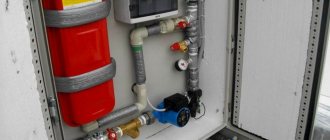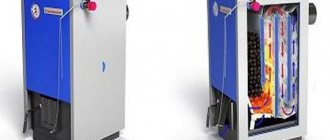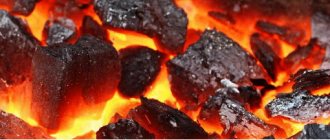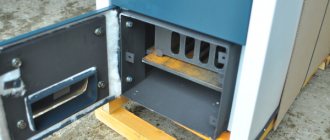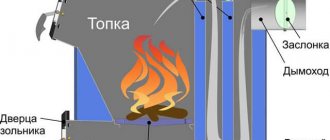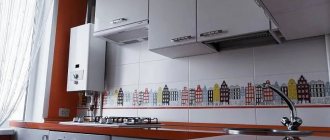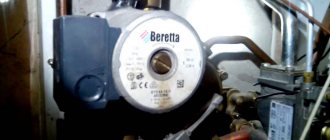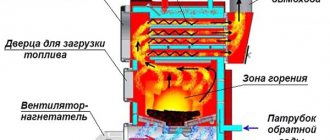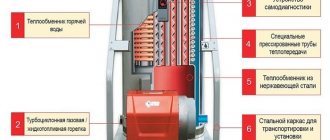Just 20 years ago, life in your own home was full of worries and associated with constant inconveniences. Unlike city apartments, the lack of central heating and sewerage created a lot of additional problems, especially in the cold season.
Today, building a country house and equipping it with all communications would seem to be no problem, but there are many nuances associated with the selection of heating devices and calculations of their power.
Choosing a boiler, what to look for
So, what do you need to know to choose a boiler? There are a number of nuances, taking into account which you can purchase a device that ideally meets all consumer needs.
To do this, when familiarizing yourself with the characteristics of the units, you must:
- find out the pros and cons of their types;
- decide on the choice of fuel on which it will operate;
- correctly calculate the power of the device;
- decide whether it will serve only for heating the room or will also combine the function of heating water;
- choose a location for the equipment and its size.
If you work through these issues in advance, you can achieve significant cost savings without loss of heat.
Boilers, firewood, heat
First, about solid fuel boilers. Pros and cons of long-burning boilers. A few names worth the attention of rural Russians:
- "Trajan" - natural craving;
- "Motor Sich" - pyrolysis;
- "Stropuva" - pyrolysis.
Read here: Storm sewer - stages of construction, features of the device and principle of operation
For example, boilers with pyrolysis (gas) combustion with wood decomposition at temperatures up to 1000 degrees. The efficiency of long-burning boilers, that is, their efficiency, reaches 93 percent.
As you can see, almost all the heat is transferred to the house through the heating of the coolant water. Their drawback is their own perfection: the electronics operate on a 220-volt network. The slightest interruption and the effect is lost.
What other long-burning boilers are there? For example, the Trayan brand, produced in Kostroma. Their advantages are also pyrolysis, but these boilers are non-volatile. The device is like a regular stove: the combustion load is at the bottom, and under it there is a vent.
The damper supports the temperature rise to 200 degrees and starts the process of releasing pyrolysis gas from the firewood. A photo of a long-burning boiler or its technological diagram will show the whole process.
Boilers "Stropuva" (Lithuania) turned pyrolysis upside down: afterburning of gases was turned down. When the chamber is fully loaded, the boilers generate continuous heat for up to a week. For a better combustion process with pyrolysis, the air must be heated to the specified temperature. And such a chamber was created in the boiler.
The only electric feature of the boiler is a fan for air supply, but the unit can do without it. In short, it is difficult to say which long-burning boiler is better. Choose for yourself.
What should be the location for installing equipment?
Depending on the location of the boiler, its dimensions and weight are selected. There is no point in installing a bulky device in a small technical room.
Some types of appliances with a power of up to 100 kW are allowed to be installed in the kitchen. Others require a separately equipped boiler room that meets safety requirements.
Boiler fuel
The great advantage of solid fuel boilers is their unpretentiousness. So, any solid materials can be used that burn well, and the soot after them does not stick to the surface of the firebox.
What can be burned:
- Diesel generators
Screen for a heating radiator - a review of the best ideas and recommendations from designers for selecting screens for a heating system
- Chimneys for gas boilers - main types and step-by-step instructions for do-it-yourself installation (video + 100 photos)
- Coal. An excellent option when you need a long-burning fuel boiler.
- Firewood.
- Pellets. Specially compressed fuel pellets.
- Peat fuel.
Depending on the region of residence, you can choose the cheapest fuel. You can find out about this in the same place where you buy a solid fuel boiler. The specialists who sell such equipment know suppliers of cheap fuel.
Types of heating devices
First of all, it should be noted that there are two types of boilers for heating a home:
- single-circuit, which are designed only for heating the area;
- double-circuit, combining heating and water heating functions at the same time.
Of course, a single-circuit boiler is cheaper than its multifunctional counterpart, but do not forget that you will have to use additional devices, such as a boiler, to heat the water.
In this case, it will take much more money to purchase two units than to buy a model that combines two characteristics.
In addition, installation of single-circuit equipment is more expensive. It is ideally designed for a room in which there is no need for hot water supply.
Check it out here too!
How to make a homemade metal detector - the best diagrams, instructions. Review of proven options for creating a simple do-it-yourself metal detectorHow to choose a washing machine: advice from professionals, the main subtleties of choosing a reliable and high-quality machine. Types, types, programs and functions
Homemade lanterns with your own hands: step-by-step instructions on how to make a beautiful and effective lantern (110 photos)
In the case of a double-circuit unit, difficulties will arise due to interruptions in heating due to intense consumption of hot water. In this situation, it is worth paying attention to the presence of a storage water heater in the design.
Such boilers are not designed to serve large rooms; they are best used in a small house, where due to lack of space it is impossible to equip a real boiler room.
Pellet boilers
Another type of wood fuel - pellets - began to be produced back in 1947 from peat, forestry and agricultural waste. These industrially produced pellets are gradually replacing both firewood and coal. A boiler operating on pellets is the same in design as a long-burning boiler.
But it has a drawback: it is equipped with electronics, therefore it is energy dependent, and the screw feeding of granules does not fit well into the home interior. The presence of such a boiler in the home heating system requires a guaranteed purchase of pellets, otherwise you may freeze in the middle of winter.
Types of equipment
When wondering which boilers are more efficient for heating a home, it should be noted that along with the difference in types of equipment, these devices are also divided into types that depend on the fuel used.
Types of boilers:
- solid fuel - burns wood, peat, coal;
- liquid fuel - diesel fuel;
- gas;
- electrical;
- universal - having the ability to switch from one type of fuel to another.
Check it out here too!
Replacing a pressure tap - a step-by-step description of how to change a pressure tap with your own hands (80 photos + video)- What is an acoustic switch: device, operation, types and features of the device (100 photos)
- Low and high pass filter: making frequency filters and how to create high-end circuitry (95 photos + video)
The choice of fuel should be determined according to the following categories:
- availability in a specific region;
- price;
- cost-effectiveness;
- energy efficiency;
- difficulty of operation.
Combination boilers
There is an option to purchase a combination boiler for heating. Solid fuel boilers are especially common. When burning solid fuel, the unit operates as a TT device. When the fire goes out, the boiler cools down and switches to electricity.
There are also combined boilers with burners for liquid fuel. It has 2 combustion chambers - for solid and liquid fuel. This type of boiler does not have the most affordable price and average level of efficiency.
Solid fuel boilers
They are considered obsolete, but are still in high demand in some post-Soviet countries. Their designs continue to be improved, and modern materials and technologies are used in manufacturing.
- availability and cheapness of fuel;
- energy efficiency;
- autonomy.
The disadvantages include the need for frequent (every 6-18 hours depending on the model) replenishment of fuel.
The exception is boilers operating on pellets; their designs allow replenishing fuel reserves every few days. Unfortunately, pellets themselves, despite all their positive qualities, are a fairly expensive type of solid fuel.
General principles for choosing a gas boiler
So, after calculating the required power of a gas boiler, you need to analyze other parameters and choose the design that suits you.
Depending on the area and size of the room, as well as on specific conditions, you need to determine the type - wall-mounted or floor-mounted is right for you. Note that a separate room is often allocated for floor-standing boilers.
In terms of economic benefits, a condensing type boiler is more preferable. It uses gas more economically and has greater efficiency, but for all that, it is more expensive and more difficult to repair and maintain.
It is important to choose the right combustion product exhaust system. Boilers with a forced system, the so-called turbocharged ones, will require the installation of a special design of two pipes - an internal one, through which smoke is removed, and an external one, through which air from the external environment is supplied to the boiler.
Thus, these boilers do not consume indoor air for combustion, and therefore they are not so demanding on space. For ordinary boilers, a vertical chimney is required, and for parapet boilers, a special coaxial one is required.
An important element of the boiler is the heat exchanger. If you plan to combine gas heating with a water supply system, choosing a boiler taking into account the heat exchanger installed on it becomes a difficult task, requiring maximum knowledge of all aspects and nuances of design features, advantages and disadvantages of individual types.
It would be better to seek help from specialists; they will help you choose the most optimal option. If gas heating is in no way connected with the water supply, choose a single-circuit boiler, this will be a rational solution.
In general, making a heating system in a house correctly is not an easy task, the solution of which must be approached with all responsibility, paying special attention to the installation of a gas boiler, since not only the efficiency, but also the safety of the entire system will depend on it.
Electric boilers
It is worth purchasing only if it is not possible to install other types of heating devices, since due to the high cost of electricity, using them is very expensive.
The advantages are:
- low cost;
- ease of installation;
- small size and weight;
- no open fire;
- ease of maintenance;
- no need for mandatory equipment of a special room.
Minuses:
- cost of electricity;
- due to the high power, it is necessary to connect to a three-phase network;
- sensitivity to power outages.
Types of solid fuel boilers
Classic solid fuel boilers
Modern classic units are an effective alternative to devices that run on other types of fuel, for example, gas, which, unlike firewood, coal, coke and briquettes, cannot always be used due to the lack of a nearby highway.
For the most part, they do not depend on electricity - they are loaded manually, operate in a natural circulation mode and have mechanical control. Some models provide automatic loading using feed hoppers - mainly for pellets, which are compressed wood pellets.
The units use several temperature control methods:
1. Using a damper that opens slightly to allow the required amount of air to pass through;
2. Using cold water added at the supply;
3. Using hot liquid supplied at the return.
Advantages:
- energy independence of many models;
- good efficiency - average efficiency is about 80%;
- versatility - in most cases;
- relatively high level of safety;
- cheap fuel - depending on the region;
- ease of operation.
Flaws:
- installation is possible only in a specially designated room;
- the need for a site for firewood, coal, briquettes;
- the need for regular maintenance, namely loading and cleaning;
- low comfort of use.
Such boilers are installed mainly in the countryside: in private houses, cottages, hotels, shops, warehouses.
Pyrolysis solid fuel boilers
A pyrolysis boiler, also called a gas generator, is an improved classic model.
It has 2 chambers connected to each other by ceramic nozzles:
1. One is intended for firewood, which at a temperature of +200 °C heats up, smolders and decomposes into coal and a volatile substance containing CO;
2. The other is used to accept pyrolysis gas generated by thermal exposure of wood.
The latter burns at a temperature of ≈ +1150 °C - preliminary ignition occurs after air supply. As a result, 2 different fuels are extracted and used from ordinary firewood - gas and charcoal, the total heat transfer of which is much higher than that of primary fuel.
When operating a pyrolysis unit, the moisture content of the wood must be taken into account - it should be no more than 20%.
Advantages:
- high efficiency – ≈ 90%;
- increased interval between downloads;
- almost complete burnout and low ash content;
- economical operation;
- compatibility with indirect heating boiler;
- possibility of automatic control, simplifying operation.
Flaws:
- the need for a special room, a platform for firewood and regular maintenance;
- dependence on power supply and log moisture;
- lack of combustion stability with incomplete filling;
- high price.
Pyrolysis boilers are distinguished by their high power; in addition, they are expensive, so they are usually installed in suburban residential and commercial buildings with a considerable square footage.
Long-burning solid fuel boilers
Among the competitors, the most expressive and efficient is the long-burning boiler called Stropuva - an innovative cylindrical unit with patented technology.
Firewood, briquettes or coal placed in the firebox are burned according to the principle of a candle, not a fire - from top to bottom, not from bottom to top. An essential role for the effectiveness of this method is played by an automatic valve - a draft regulator, which expands or contracts depending on the heating value.
There are practically no temperature surges in these units; as a result, excess heat is not discharged into storage tanks due to its absence.
One stack of firewood weighing 50 kg is enough for uninterrupted heating of a room of 130 m2 for 30 hours. In addition, the fuel burns virtually to a residue - after burning coal, cleaning is carried out weekly, in the case of logs - once every 14 days.
Advantages:
- energy independence of many models;
- optimal efficiency – approximately 85%;
- long burning interval;
- no impact of loading on efficiency;
- economical use;
- ease of use.
Flaws:
- the need for maintenance, premises and areas for storing fuel;
- inconvenient doors, regardless of model;
- high price.
Objects for using such devices are private households, as well as small-sized commercial and outbuildings. For large buildings and structures, the units are mounted in a cascade.
Gas boilers
The best types of boilers for heating. There are floor or wall mounted. Economical and easy to use.
They are most effective when connected to the main fuel supply. When using cylinders or gas holders, they are less economical, but still more profitable than other types.
- low energy price;
- does not require specific maintenance;
- full automation of work.
Flaws:
- dependence on electricity to automate gas supply control;
- installation of automation that controls leakage;
- sensitivity to pressure surges;
- the need to obtain permission to install equipment.
Types of solid fuel boilers
You can choose the best solid fuel boiler. But before purchasing, you should familiarize yourself with the types of these units, which differ from each other in many characteristics. There are four main types of solid fuel equipment:
- Classic.
- Pyrolysis.
- Long burning.
- Automatic.
Classic version
Regular wood boiler
The operation scheme of the classic unit is such that heat is obtained by flaming combustion of fuel. Boilers have two doors. Through one, fuel is loaded, and through the other, ash and other combustion products are removed. They can operate on both wood and coal. The heat exchanger can be made of different materials: cast iron or steel.
Gas generator models
The operation of this type of solid fuel boiler is based on the process of pyrolysis (decomposition and gasification of solid fuel). This process is activated when the chimney is closed and the combustion chamber is closed. After the gas from the logs is released during the pyrolysis process, it moves into the burner nozzle, and there it mixes with secondary air, which is pumped by the fan. The gas mixture is then directed into the combustion chamber and ignited there. Combustion occurs at temperatures sometimes reaching 1200 °C. The process will continue until the solid fuel burns completely.
Gas-generating solid fuel boilers are characterized by a very high efficiency, reaching up to 90%. In this case, the duration of combustion can be almost 10 hours. Units of this type are very easy to operate due to the complete combustion of logs, and control of the air supply makes it possible to completely regulate the temperature of the coolant.
Long burning boiler
Operating principle of a long-burning boiler
In this case, prolonged combustion is ensured by special techniques. Today, two long-burning systems are known - Buleryan (Canada) and Stropuva (Baltics), but the second is not so popular due to its high cost, difficult operation and other technical parameters. When thinking about how to choose a long-burning solid fuel boiler, remember that by and large these are the same gas generating units, but their operating principle is different.
Buleryan equipment is a furnace with two chambers, where smoldering and gas formation are carried out in the lower compartment. After the gas enters the second chamber, it mixes with air and the fuel burns without any residue.
The design of such a solid fuel unit has a cylindrical shape with pipes welded into it for half a circle. The arrangement of the pipes from bottom to top makes air circulation better and thus heat transfer is higher.
Installation is usually carried out in non-residential premises; it is perfect for heating a garage and a summer house.
The Stropuva system has two cylinders, where one is located inside the second (in the form of a nesting doll). The space between the cylinders is filled with slowly heating water. The inner cylinder is assigned the function of a combustion chamber, into which air enters through a distributor. After fuel loading, combustion begins from top to bottom, causing the water to heat up.
Automatic boiler
This solid fuel boiler involves automated fuel loading and ash removal. It has screw and conveyor hoppers for fuel supply and automatic ash removal. In coal models, there is movement of the fuel combustion layer, which is necessary for complete combustion. For this purpose, movable grate bars (or chopping and moving mechanisms) are built into the automatic boiler. There is forced pressurization for optimal water heating and fuel combustion.
The following advantages of automatic solid fuel boilers can be highlighted:
- They do not require labor-intensive maintenance and constant supervision by the owner.
- The standard equipment of the boiler includes a temperature regulator.
- Most have sensors that monitor the temperature in the boiler itself.
- The efficiency can be as high as 85%.
- Long-term operation, which is limited only by the capacity of the hopper for automated fuel supply.
Fuel consumption, including coal, is significantly less in automatic boilers compared to classic solid fuel units.
Universal boilers
They are attractive due to the interchangeability of fuel types without affecting the thermal characteristics of the equipment.
Can be:
- multi-fuel - alternately work on both electricity and solid fuel, diesel or gas;
- dual-fuel - they combine only two types of fuel in a combination depending on the specified characteristics of the device.
They require competent maintenance and careful operation.
Electric gas boiler
If it is possible to allocate the required amount of kW, you can install an electric boiler. It is very easy to use, silent, and does not require serious maintenance.
But in the future you will have to pay considerable amounts for electricity.
Electric boilers are divided into 3 types:
On tens. They have several modes, are easy to maintain, but have a low efficiency.
Induction. These units are the most economical and have a very compact size. In the absence of a coolant, they burn out very quickly.
- Decoupage furniture - photo examples and a guide for beginners
- Decorative plaster application technology - photo technology for finishing walls and ceilings
- Corrugation for a toilet bowl - features of material selection and installation + 50 photos
Electroid. The least popular option, since with it the heating system is practically energized.
Power calculation
After a decision is made in favor of the type of fuel, the power of the equipment should be determined.
How to find out the required boiler power for heating? To do this, you need to be guided by an approximate calculation algorithm, in which heating a room with a volume of 30 cubic meters will require 1 kW and a mandatory reserve of 20%.
In addition, it is worth considering:
- Device efficiency;
- number of users;
- level of thermal insulation (what materials the house is made of);
- level of heat loss (number and area of windows and doors);
- climatic conditions;
- Will there be water heating?
Keeping these nuances in mind, it will be problematic for a non-specialist to independently calculate the boiler power.
Even using special design standards, an amateur can make many mistakes and, as a result, make the wrong device.
In this case, the best solution would be to use the help of a professional who will not only determine the required power of the device, but also tell you in which case you can save money.
What is a gas boiler?
Gas boilers for a private home are a device that provides uniform heating of a residential area. Natural gas is used for heating. During the combustion of this substance, thermal energy is released.
Modern models of heating equipment have many options that allow you to choose the rate of heat supply to the room and reduce the volume of raw materials consumed.
The basic principle of operation of a gas boiler is that fuel is supplied to the electric ignition device. When the ignition is started, a spark is produced that ignites the igniter. If it is missing, the gas supply is blocked.
An automatic safety system blocks the leakage of raw materials and prevents the accumulation of flammable material indoors.
Useful tips
In addition to the above, experts offer some more tips for choosing boilers:
- pay attention to whether service is included in the purchase and sale agreement; if not, it is better to conclude it additionally or look for a product where it will be indicated.
- carefully look at the manufacturer’s warranty periods and obligations;
- collect information and reviews about the manufacturer and this boiler model.
Classification of gas boilers
There are several types of gas boilers:
- in terms of functionality, one- and two-circuit;
- according to the method of removing combustion products, traditional and condenser;
- according to the installation method: wall and floor.
The main difference between double-circuit heating systems and single-circuit analogues is their functionality. In addition to their main purpose, they are capable of providing a private home with hot water supply.
Types of domestic gas boilers
If we compare traditional and capacitor units, the former have significantly lower efficiency. Increasing this parameter in a condenser-type installation is achieved by using the heat released by combustion products and contained in water vapor.
Floor-standing models have great power and functionality, but they are very bulky. It makes sense to install wall-mounted analogues when there is limited free space. The material for the manufacture of floor-standing models is cast iron, known for its excellent heat transfer and durability. Wall-mounted models made of steel are resistant to mechanical damage and compact. They will easily fit in the kitchen or attic.
Wall-mounted gas boiler
Manufacturers pay special attention to the presentable appearance of the installations. Thanks to this, the consumer can always choose a gas boiler in accordance with the design of the room.
A good boiler will warm the house in any cold weather
If heat and hot water are supplied to city apartments centrally, and the service company is responsible for this, then in order to organize modern heating and water heating, the owners of a private house themselves must purchase the necessary equipment.
In this case, a competent selection of a boiler for heating will help not only keep the house warm, but also use hot water, as well as save money on maintenance and upkeep.
Classification
Heating heat generators (boilers) differ in price, which depends on quality and functionality, external parameters and operating principle. In modern times, the range is very wide, so many people wonder: which boiler is better to choose for the home.
First, you should find a boiler that suits you according to the type of fuel consumed, and then look at the other parameters of this fuel. It is important to remember: this choice may be different for each consumer, even if they are neighbors.
There are the following types of heating boilers:
- Gas boilers (most common)
- Liquid fuel (powered by combustible fuel such as diesel)
- Electric (a more modern option, the downside is that a power outage also turns off the boiler)
- Solid (practically not used due to poor environmental friendliness)
- Combined.
Photos of heating boilers
Read here - How to choose an audio transmitter: TOP review of modulators, transmitters, their characteristics and functions (115 photos + video)
Single-circuit gas boilers
The main task of single-circuit gas units is to heat the room by circulating water without the use of pumping units. But most modern models on the market provide the ability to connect the boiler through shut-off valves of technical units. To provide hot water supply, sanitary water is passed through a heat exchanger of a boiler connected to the boiler, heating it to the required temperature.
Models that provide a connection to a boiler are available in different designs:
- The boiler is located separately from the boiler. In this case, the electronic temperature sensors of the water heater are connected to the gas boiler operation control system. The desired water temperature is set on the water heater, and the gas boiler will be responsible for maintaining it.
- The boiler is built into the heating element. The operating principle of the system is identical to that described above. The only difference between built-in and separately located units is that in the first case, due to the compact design, the maximum volume of the container is limited and can exceed 100 liters.
Connecting a single-circuit gas boiler
The design of a single-circuit floor-standing boiler is quite simple. It consists of a combustion chamber with a burner housed in it and a coil located on top of the heat exchanger. The units are equipped with an automatic ignition function; the operation of the boiler is controlled by temperature sensors. Combustion products are removed through the chimney.
The main advantage of this type of heating system can be considered:
- Power. Cast iron floor units are renowned for their high performance. Depending on the power of the unit, which varies from 10 to 80 kW, they are capable of heating housing with an area of 100 sq.m or more.
- Gas consumption. Compared to dual-circuit models, this type of installation consumes less gas, which significantly saves heating costs.
- Price. It is profitable to purchase such boilers because of their low cost. They are easy to maintain and are not dependent on the power supply system. But it is worth considering that the total cost of a single-circuit unit and a boiler will be higher than the price of a double-circuit unit.
Connecting a single-circuit gas boiler Attention! To increase the performance of the unit, experienced users recommend pouring a special liquid into the heating system, which contains antifreeze additives. Their use will not only allow you to quickly warm up rooms, but also prevent radiators from freezing when the ambient temperature drops below zero.
Double-circuit gas boilers
A double-circuit system is a more complex system equipped with two heat exchangers:
- primary – performs the function of heating the coolant for heating;
- secondary - heats water to provide hot water.
Both circuits cannot function at the same time. When the unit operates in heating mode, the combustion gas heats the primary heat exchanger, which, under the action of the circulation pump, directs the coolant to the radiators. The three-way valve prevents coolant from entering the hot water system.
When the boiler is started in DHW mode, the coolant flows from the heated primary heat exchanger to the secondary one. There, circulating, it heats water for domestic use. In this case, the three-way valve prevents coolant from entering the heating system.
Construction of a double-circuit gas boiler
Almost all models of gas boilers are equipped with an automatic control system. The operation of the simplest models is controlled by a mechanical thermostat, while in more expensive ones - by electronic devices. If necessary, the clutch is activated and the pump is turned on, which accelerates the coolant throughout the entire circuit of the heating system.
Thanks to this, they operate uninterruptedly even when the gas pressure in the system decreases.
The main advantages of double-circuits:
- Compactness. With the highest possible efficiency, which reaches 90%, double-circuits do not take up much space. The units are compact in size and moderate in weight.
- Multifunctionality. The dual-circuit system can be connected to both wall-mounted and floor-mounted equipment.
- Power. The models presented for sale have a power ranging from 12-35 kW, which is enough to heat private houses with an area of 50 to 350 sq.m.
Diagram: connecting a gas double-circuit boiler.
A significant disadvantage of double-circuit boilers is the vulnerability of the secondary heat exchanger. Due to the constant supply of cold tap water, which contains impurities, they are more susceptible to corrosion. If this happens and the secondary heat exchanger fails, then the boiler can only be used in heating mode.
There are several ways to prevent this problem by extending the life of the unit:
- Install a water filter;
- Clean the heat exchanger regularly every 3-5 years;
- Heat water no higher than 50°C.
Attention! A double-circuit boiler is far from the best choice if it is necessary to heat large premises, provided that the water intake devices are located at a considerable distance from the heating unit itself.
